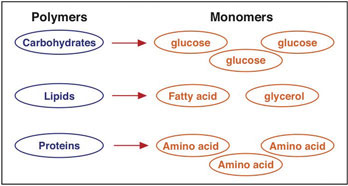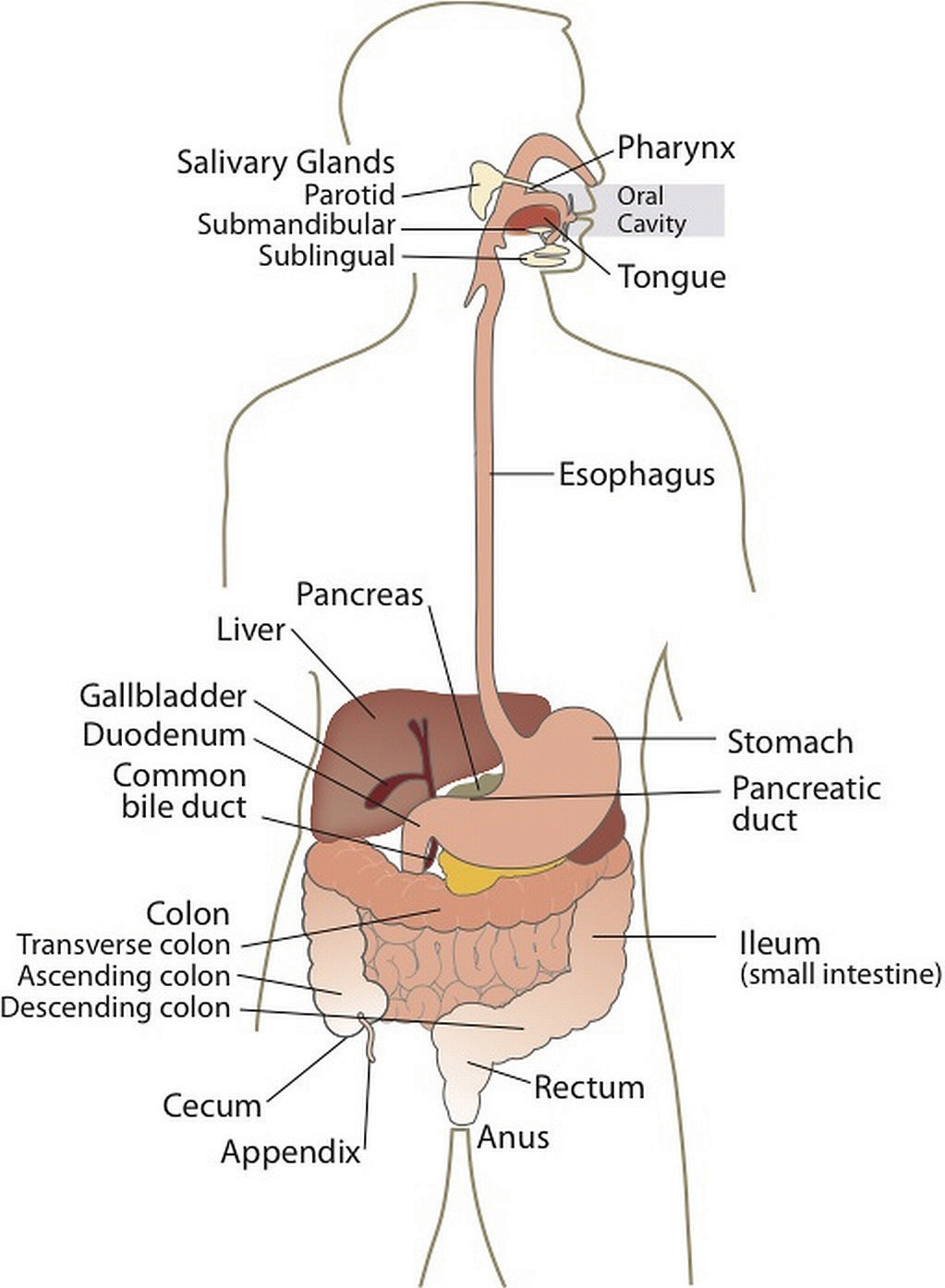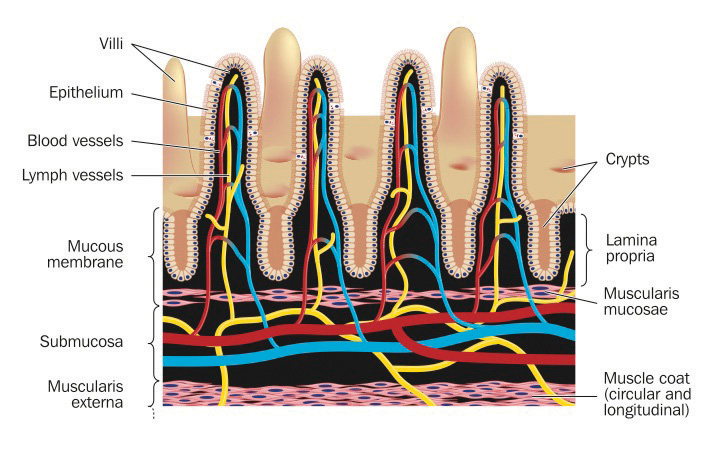Once Chyme Leaves the Stomach Where Does It Enter?
3.3: The Digestion and Absorption Process
- Varlet Idaho
- 5971
Skills to Break
- Sketch and judge the major organs of the digestive organisation and state their functions.
Digestion begins even earlier you put food into your mouth off. When you feel hungry, your body sends a substance to your mind that it is time to eat in. Sights and smells influence your body's preparedness for food. Smelling food sends a message to your brain. Your brain then tells the mouth to get ready, and you start to drool in preparation for a delectable meal.

Figure 2.3.1: The Digestion Process. Digestion converts the food we fret smaller particles, which will exist processed into energy or used as edifice blocks.
Once you have eaten, your digestive system (Figure 2.3.1) breaks dispirited the solid food into smaller components. Another word for the equipment failure of complex molecules into smaller, simpler molecules is "dissimilation". To do this, dissimilation functions happening two levels, mechanical and chemical. Once the littler particles have been broken down, they will be absorbed into the blood and delivered to cells throughout the consistency for Energy Department Oregon for building blocks required for cells to use. The gastrointestinal system is same of the eleven organ systems of the humanlike body and IT is composed of several hollow tube-shaped organs including the verbalise, pharynx, esophagus, stick out, small intestine, large intestine (or colon), rectum, and anus. Information technology is lined with mucosal tissue that secretes digestive juices (which aid in the dislocation of food) and mucus (which facilitates the propulsion of food through the tract). Involuntary muscle tissue surrounds the digestive tract and its contraction produces waves, known as peristalsis, that propel food down the piece of ground. Nutrients as well as some non-nutrients are absorbed. Substances such arsenic fiber get left-of-center behind and are appropriately excreted.
From the Mouth to the Stomach
There are quaternion stairs in the digestion treat (Figure 2.3.2). The first step is intake, which is the collection of food into the digestive tract. It may seem a simple process, simply intake involves smelling food, thinking about food, and the involuntary release of saliva, in the mouth to prepare for food entry. In the oral fissure, where the second step of digestion occurs, the machinelike and chemical breakdown of nutrient begins. The chemical breakdown of solid food involves enzymes, which break apart the components in food. In the mouth, the enzyme amylase is secreted to begin breaking down complex saccharide. Mechanical breakdown starts with mastication (chewing) in the speak. Dentition crush and grind great food particles, while saliva initiates the chemical breakdown of food and enables its cause down. The slippery mass of part broken-down food is called bolus, which moves down the organic process parcel of land as you swallow. Swallowing Crataegus laevigata seem voluntary at first because it requires conscious effort to push the food with the tongue backwards toward the pharynx, only subsequently this, swallowing takings involuntarily, meaning it cannot be stopped once it begins.

Figure 2.3.2: The Human Gastrointestinal system : © Networkgraphics
As you swallow, the bolus is pushed from the mouth off through the pharynx and into a brawny subway called the esophagus. Equally it travels through the throat, a itty-bitty undulate called the epiglottis closes, to prevent choking by keeping food from going into the windpipe. Peristaltic contractions in the esophagus propel the food down to the stomach. At the articulation between the gorge and tum, there is a sphincter that remains closed until the food bolus approaches. The pressure of the solid food bolus stimulates the lour esophageal sphincter muscle to relax and open and food then moves from the esophagus into the stomach. The mechanised dislocation of food is accentuated by the muscular contractions of the stomach and small intestine that mash, mix, slosh, and propel food down the GI tract. Cubic food takes between four and viii seconds to travel down the esophagus, and liquids take about indefinite second.
From the Stomach to the Small Gut
When food enters the tum, a extremely muscular organ, powerful peristaltic contractions help mash, pulverize, and churn food into chyme. Chyme is a liquid mass of partially digested food that also contains gastric juices secreted away cells in the stomach. Cells in the digest also secrete hydrochloric sour and the enzyme pepsin, that chemically breaks down protein into small molecules. A thick mucus cake lines the stomach to protect IT from digesting itself. The stomach has three basic tasks:
- To store food
- To mechanically and chemically expose down solid food
- To empty partially broken-down food into the small intestine
The length of time food spends in the stand varies by the macronutrient writing of the meal. A eminent-fat or high-protein meal takes longer to gap down than one rich in carbohydrates. Information technology usually takes a a couple of hours after a meal to empty the stomach contents completely. The anatomical sphincter that allows chyme to pass into the small intestine is known as the pyloric anatomical sphincter.
Video 2.3.1: Digestion Video
This video shows the mechanical and chemical substance breakdown of food into chyme.
The small intestine is split into deuce-ac cognition parts: the duodenum, the jejunum, and the ileum. Formerly the chyme enters the duodenum (the offse section of the small intestine), three accessory (or helper) organs: liver, pancreas, and gallbladder are stimulated to release juices that aid in digestion. The pancreas secretes leading to 1.5 liters of pancreatic succus finished a duct into the duodenum per day. This fluid consists mostly of water, only it also contains bicarbonate ions that do i the acidity of the stick out-derived chyme and enzymes that further die proteins, carbohydrates, and lipids. The gallbladder secretes a much smaller amount of gall to help digest fats, also through a channel that leads to the duodenum. Bile is made in the liver and stored in the gallbladder. Gall's components act like detergents by surrounding fats siamese to the way dish soap removes grease from a frypan. This allows for the movement of fats in the watery surround of the small intestine. Two different types of muscular contractions, called peristalsis and segmentation, move and mix the food in respective stages of digestion through the small intestine. Similar to what occurs in the esophagus and stomach, vermiculation is circular waves of smooth muscle contraction that propel food forward. Segmentation sloshes nutrient back and forth in some directions promoting further admixture of the chyme. Almost whol the components of food are entirely broken down to their simplest unit within the first 25 centimeters of the small intestine. Instead of proteins, carbohydrates, and lipids, the chyme now consists of amino acids, monosaccharides, and emulsified fat acids.
The side by side step of digestion (nutrient absorption) takes place in the remaining length of the itsy-bitsy gut, or ileum (> 5 meters).

Figure 2.3.3 : The room the small intestine is structured gives information technology a Brobdingnagian surface area to maximize nutrient preoccupation. The surface area is increased by folds, villi, and microvilli. Digestible nutrients are absorbable into either capillaries or lymphatic vessels controlled within each microvilli. © Shutterstock
The bitty intestine is perfectly structured for maximizing nutrient absorption. Its surface area is greater than 200 square meters, which is about the size of a tennis Margaret Court. The surface area of the humble bowel increases by quaternary levels of folding. The internal tissue of the small intestine is covered in villi, which are tiny fingerbreadth-like projections that are covered with even smaller projections, called microvilli (Figure 2.3.3). The digested nutrients pass through the absorptive cells of the intestine via diffusion or special transport proteins. Amino acids, minerals, alcohol, water answerable vitamins, and monosaccharides (sugars like glucose) are transported from the intestinal cells into capillaries, but the much larger blended fatty acids, fat-soluble vitamins, and other lipids are transported first through lymphatic vessels, which before long meet up with blood vessels.
From the Small Intestine to the Large Gut
The process of digestion is fair efficient. Any nutrient that is still incompletely wiped out down (usually inferior than ten percent of food consumed) and the food's indigestible vulcanized fiber content moves from the belittled intestine to the man-sized intestine (colon) through and through a connecting valve, ileoceceal sphincter. The main task of the large intestine is to reabsorb piss. Remember, water is award not only in undiversified foods but also the stomach releases a couple of century milliliters of gastric juice and the pancreas adds approximately another 500 milliliters during the digestion of the repast. For the body to conserve water, it is important that the water is reabsorbed. In the large intestine, no boost chemical Oregon mechanical breakdown of food takes place, unless IT is accomplished by the bacteria that dwell this portion of the GI tract. The number of bacteria residing in the large intestine is estimated to be greater than 10(14), which is more than the total come of cells in the weak body (10(13)). This may seem rather unpleasant, but the great majority of bacterium in the large gut are harmless and just about are even beneficial. The bacteria synthesize the essential nutrient, vitamin K, myopic chain fatty acids, which are basal for our wellness, from the undigested fiber. Besides, minerals, such as sodium and potassium, are absorbed.
Kefir
There has been significant discourse pre- and probiotic foods in the mainstream media. The World Wellness Organization defines probiotics as live bacteria that confer beneficial wellness effects connected their host. They are sometimes called "congenial bacterium." The most common bacteria labeled as probiotic is drink acrid bacterium (lactobacilli). They are added as live cultures to certain fermented foods such as yogurt. Prebiotics are indigestible foods, primarily soluble fibers, that stimulate the growth of certain strains of bacteria in the biggish intestine and provide health benefits to the Host. Examples of prebiotics would be inulin, disintegrable fiber and nonabsorptive starch. A review clause in the June 2008 issue of the Journal of Nutrition concludes that there is a scientific consensus that probiotics ward off microorganism-evoked diarrhea and deoxidise the symptoms of lactase deficiency.Farnworth, E. R. "The Evidence to Support Health Claims for Probiotics." J Nutr 138, no. 6 (2008): 1250S–4S. http://jn.victual.org/content/138/6/1250S.agelong. Expert nutritionists agree that Sir Thomas More health benefits of pre- and probiotics will likely reach a scientific consensus. As the Fields of pre- and probiotic manufacturing and their nonsubjective consider progress, more information happening comely dosing and what direct strains of bacterium are potentially "friendly" will become available.
Figure 2.3.4: Kefir, a dairy product fermented with probiotic bacteria, can make a pleasant tasting shake. (CC BY-Storm Troops 3.0; Quijote )
You Crataegus oxycantha be concerned in trying some of these foods in your diet. A caudate nutrient to try is kefir. Respective websites provide good recipes, including www.kefir.net/recipes.htm.
From the Colossal Intestine to the Anus
After a few hours in the stomach, advantageous three to sise hours in the small intestine, and about sixteen hours in the expectant bowel, the digestion process enters footprint four, which is the elimination of indigestible food for thought as feces. Feces contain indigestible food for thought and gut bacteria (almost 50 percent of content). It is stored in the rectum until IT is expelled through the anus via defecation.
Video recording 2.3.2: The Stages of Digestion
This video recording reviews the sequence of events during food digestion.
Processes of Digestion
Digestion involves two processes - physical and chemical. During the physical process, the food is mixed and stirred throughout the GI tract. This unconscious process is too referred to as motility and the partially digestible food is propelled by the wave-like action named peristalsis. Ring-wish muscular valves called sphincters prevent the back fall of part digested food and digestive juices. There are sphincters between the esophagus and stomach (esophageal sphincter), 'tween the venter and small gut (pyloric valve) and small intestine and colon (ileocecal sphincter).
The chemical process of digestion involves the release of water system, acid, bicarbonate and enzymes to be mixed with the food to boost break it down into smaller subunits. Chemical breakdown starts in the back talk where enzymes break down complex saccharide. In the stomach, water and acid are free to begin the breakdown of protein. A mucus lining protects the stomach from the corrosive acrid. The mixture, a.k.a. chyme, enters the small intestine where bicarbonate is introduced to neutralize the acid and enzymes are added to break stuff bonds. Most small intestine digestive enzymes are produced in the pancreas and small intestine.
Regulation of Digestion
Our systema nervosum and hormones control digestion. The nervous scheme consists of the central nervous system, and the peripheral nervous system. Our brain and spinal cord manufacture the central nervous system while the peripheral system lies outside the skull and bone column. There are two components to the peripheral system: the somatic system that supplies the skin and heftines, and the autonomic system which supplies wax-coated muscle, cardiac muscle, and glands. The autonomic system has two divisions: the parasympathetic (PSNS or PNS) and sympathetic system (SNS). The PSNS supplies signals to observe normal function and conserve body processes. The SNS provides signals to accelerate the process. Our gastrointestinal tract receives signals from the central and autonomic systems as well as sends signals to these systems.
https://web.youtube.com/watch?v=hWks2wS56Qs
Hormones are also involved in regulation digestion. Your organic process tract secretes hormones to control the waiver of organic process enzymes and juices. Here is a postpone of some hormones.
| Hormone | Origin | Stimulus | Action |
|---|---|---|---|
| Gastrin | Digest | Nutrient, especially proteins, caffeine, spices, alcoholic beverage | Stimulates stomach acids and enzymes |
| Cholecystokinin (CCK) | Small Intestine | Adipose tissue and protein | Stimulates pancreas and coloured secretions (enzymes and gall) for protein and fat digestion |
| Secretin | Soft Intestine | Elvis (from suffer) in belittled intestine | Secretes bicarbonate to neutralize acid |
| Gastric inhibitory protein (GIP) | Small Intestine | Fat and protein | Inhibits gastric move and secretion of gastric juices |
Our appetite and hunger are controlled by a complex sue that involves many signals. Here is a abbreviated overview of that process.
https://www.youtube.com/watch?v=bQT17Mifh94
Key Takeaways
- The breakdown of complex macromolecules in foods to deltoid absorbed components is accomplished past the organic process system. These components are processed by cells throughout the torso into energy operating theater are used as building blocks.
- The digestive system is composed of the talk, throat, gullet, stomach, small intestine, large gut (or colon), rectum, and anus. There are four steps in the digestion process: ingestion, the mechanically skillful and chemical breakdown of food, nutrient absorption, and elimination of heavy food.
- The mechanical equipment failure of food occurs via athletic contractions called peristalsis and segmentation. Enzymes secreted by the salivary glands, stomach, pancreas, and small intestine accomplishes the chemical breakdown of food for thought. Additionally, gall emulsifies fats.
Discussion Starter
-
Decide whether you desire to consume pre- and probiotic foods to benefit your wellness. Chat the websites below to help in your determination-devising process. Defend your decision scientifically.
http://www.wellness.Harvard University.edu/fhg/updates/update0905c.shtml
nccam.nih.gov/research/results/spotlight/110508.htm
Once Chyme Leaves the Stomach Where Does It Enter?
Source: https://med.libretexts.org/Courses/American_Public_University/APU:_Basic_Foundation_of_Nutrition_for_Sports_Performance_%28Byerley%29/03:_Digestion_and_Absorption/3.3:_The_Digestion_and_Absorption_Process
0 Response to "Once Chyme Leaves the Stomach Where Does It Enter?"
Post a Comment